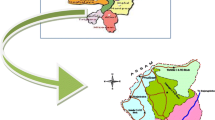Abstract
The present study was carried out during 2014–16 to document the wild edible fruits of central Manipur with respect to their ethno-medicinal uses and socio-economic importance among the rural people. Altogether 49 species of fruits recorded which are represented by 22 families. Among all, Rosaceae is the most used family with 10 species, followed by Moraceae and Rutaceae by 7 species, Phyllanthaceae by 4 species, Anacardiaceae, Arecaceae and Rubiaceae each by 2 species and rest all one species each. In terms of socio economic importance of these fruits, most of the wild fruits are use for construction of houses, firewood, fodder for domestic animals and charcoals in rural life. These fruits are also use to make dyes for use in traditional handicrafts and to make oils. Most of these fruits are available in the local market, in the price range of Rs. 20 to Rs. 100 per kg. In spite of these versatile uses, these fruits have not yet been properly documented. Hence, there is urgent need to document these valuable species before they become extinct.


Similar content being viewed by others
References
Anonymous (1950) The wealth of India, a dictionary of Indian raw materials and industrial products. (Raw materials 2). Publication and Information Directorate, CSIR, New Delhi
Bahuguna VK (2000) Forests in the economy of the rural poor. An estimation of the dependency level. Ambio 29:126–129
Comex SA de CV, Sierra A, SC/Conservation International (2007) Hotspots revisited. Conservation International, Washington DC, USA. www.conservation.org. Accessed 20 Dec 2008
Dwebe TP, Mearns MA (2011) Conserving indigenous knowledge as the key to the current and furure use of traditional vegetables. Int J Inf Manag 31:564–571
Hazarika TK, Pongener M (2017) Potential wild edible fruits of Nagaland, North-east India and its significance in the livelihood and nutritional security of rural, indigenous people. Genet Resour Crop Evol. doi:10.1007/s10722-017-0523-3
Hazarika TK, Lalramchuana, Nautiyal BP (2012) Studies on wild edible fruits of Mizoram, India used as ethno-medicine. Genet Resour Crop Evol 59:1767–1776
Jain SK (1967) Ethnobotany, its scope and study. Ind Mus Bull 2:39–43
Jain SK (1986) Ethnobotany. Interdiscip Sci Rev 11:285–292
Jain SK, Rao RR (1977) A handbook of field and herbarium methods. Today and Tomorrow’s Printers and Publishers, New Delhi
Mahapatra AK, Mitchell CP (1997) Sustainable development of non-timber forest products: implication for forest management in India. For Ecol Manag 94:15–29
Maikhuri RK, Rao KS, Krishna GS (2004) Bio prospecting of wild edibles for rural development in the central Himalayan mountains of India. Mt Res Dev 24:110–113
Mitre (1991) Medicinal plants research in India—a review. Ethnobotany 3:65–77
Mohapatra SP, Sahoo HP (2010) The status and use of tree biomass in the tribal village ecosystem of Bolangir District, Orissa, India. Afr J Pl Sci 4:445–450
Pandey A, Tomer AK, Bhandari DC, Pareek SK (2007) Towards collection of wild relatives of crop plants in India. Genet Resour Crop Evol 55:187–202
Shiva MP (1996) Inventory forestry resources for sustainable management and biodiversity conservation. Indus Publishing Company, New Delhi
Shrestha PM, Dhillion SS (2006) Diversity and traditional knowledge concerning wild food species in a locally managed forest in Nepal. Agro for Syst 66:55–63
Sundriyal M, Sundriyal RC (2001) Wild edible plants of the Sikkim Himalaya: nutritive values of selected species. Econ Bot 55:377–390
Watt G (1892) A dictionary of the economic products of India. Vol. VI, part I, (Reprint, 1972). Gordhan and Company, Delhi
Author information
Authors and Affiliations
Corresponding author
Ethics declarations
Conflict of interest
The authors declare that there is no conflict of interest in whatsoever.
Rights and permissions
About this article
Cite this article
Hazarika, T.K., Singh, T.S. Wild edible fruits of Manipur, India: associated traditional knowledge and implications to sustainable livelihood. Genet Resour Crop Evol 65, 319–332 (2018). https://doi.org/10.1007/s10722-017-0534-0
Received:
Accepted:
Published:
Issue Date:
DOI: https://doi.org/10.1007/s10722-017-0534-0




